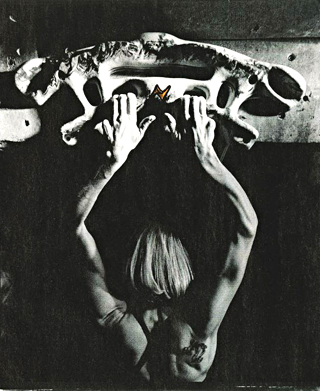Intro to Hangboard Training

NICROS’ Warrior Board.
While climbing is, first and foremost, a mental and technical skill sport, long-term improvement—and pursuing your genetic potential—demands getting stronger in a number of climbing specific ways. Numerous research studies have confirmed that elite climbers, compared with non-elites, have higher grip-strength-to-mass ratio, greater forearm endurance, and a higher rate of force development in the finger flexors. Not surprisingly, then, the fingerboard has become the single most important piece of training equipment a climber can own. While actual climbing must always comprise the backbone of an effective training program (skill first!), the act of climbing is not the most effective way to develop grip strength.
Enter the fingerboard (or “hangboard”, if you prefer). Since its advent in the mid-1980s, the fingerboard has become the most used type of training equipment among avid climbers—and for good reason: brief, high-intensity straight-armed hangs are the single most effective isolation exercise a climber can do. What’s more, the fingerboard is economical, and it can be mounted in just about any apartment or home. If you are an avid climber and desirous of the higher grades, then a fingerboard is the second best investment you can make in your future climbing ability (#1 is to join a climbing gym). For an individual without access to a climbing gym, then, owning a fingerboard is essential!
FINGERBOARD TRAINING—A SMART PLAN IS ESSENTIAL
The obvious strong points of the fingerboard are its ease of access and the ability to isolate a variety of grip positions in a highly specific way. While not appropriate for true beginners, experienced climbers can progressively add weight to their body to train maximum grip strength with a series of brief, high-intensity hangs. The strategy for training strength-endurance is to do a higher number of less-intense hangs (with body weight or less).
Being able to vary the training load is an important aspect of effective fingerboard training. While you can indeed adjust intensity up and down by using smaller and bigger holds, respectively, it’s also important to be able to adjust resistance while training on a specific hold such as the common 20mm (3/4”) edge. To increase resistance, simply wear a weight vest or hang free weights from the belay loop of your climbing harness. For resistances less than bodyweight you can employ a pulley system with counterweights—especially useful for training one-arm hangs and learning one-arm pull-ups. (A good pulley system is available from Trango, although you can easily kludge a counterweight rig with pulleys bought at Home Depot.)
To get the most out of your fingerboard training sessions, it’s important to follow a well-designed program rather than ad lib a workout of “hanging a bunch” or simply “hanging to total failure.” These approaches will provide limited gains and might even get you injured. The best approach for increasing your maximum grip strength is a series of brief high-intensity hangs with extensive rest between each hang. While it might not seem like a good workout, doing 7- to 10-second hangs with one to three minutes rest in between is a very effective program for building maximum grip strength (as long as the hangs are difficult, via small holds or by adding weight). Do three to five hangs per grip position–train all the primary grips this way. For endurance you want to do somewhat longer hangs, but with less resistance and shorter rest intervals. For example, alternating 20-second hangs with 20- to 40-second rests for a total of two or four minutes will gradually pump you up. There are numerous other protocols for training strength and endurance…which I’ll detail in future articles.

NICROS NexGen hangboard.
It’s essential to train with good hangboard technique: Maintain moderate tension throughout your shoulders and upper torso by engaging your scapular stabilizers and maintaining a slight bend in your arms; relax from the hips down and avoid lifting your knees; most important, do not relax your shoulders and allow them to elevate into an extreme shrug position nearer your ears. Also, it’s vital to do preparatory and concurrent training of the scapular stabilizers and rotator cuff muscles.
A word of caution: misuse of the fingerboard has contributed to finger (tendon) and shoulder injuries in countless climbers. Intensive fingerboard training should be limited to just two days per week—three at most, if you are doing no other climbing—and, ideally, as a supplement to climbing rather than a replacement for actual climbing. A gradual warm up is essential beforehand, including a general activity to elevate heart rate, followed by various mobility exercises and some self-massage of the fingers and forearms. Complete your warm-up with some pull-ups on large holds. It’s also a good idea to conclude your fingerboard training with a few sets of the antagonist training of the wrist stabilizers.
WHAT’S THE BEST HANGBOARD FOR YOU?
The hangboard you use is secondary to the training protocol and the quality of your overall training-for-climbing program. Really, you could drill finger pockets into a piece of 2×10 and screw on a few ¾” wood edges, and you’d have a decent training board (I know, because that’s how I made my first hangboard in the mid 1980s!). Today, however, there are several excellent plastic and wood handboards on the market, so for most people buying a hangboard or two (or three or four!) is the way to go. In my home gym, I have more than a dozen hangboards including two I designed for NICROS, the NexGen and V10, and the popular Warrior Board.
So what are you waiting for? Get a hangboard and start training for stronger fingers!

